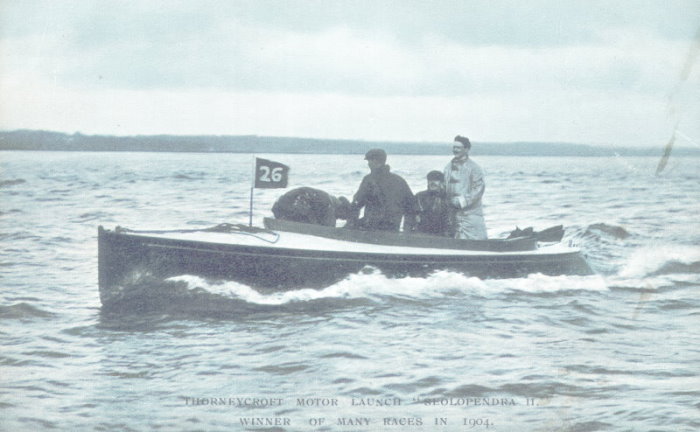Where it all began!
| Where it all began! Reproduced with the permission of Ed Williams-Hawkes.In 1903 John Thornycroft entered the first running of the Harmsworth Trophy and the Yachtsman’s Cup Handicap Race for auto-boats in his cedar planked on an American elm frame, boat Scolopendra, named after, some say, a fictitious sea monster. She had a turtle-back foredeck and pine planked deck aft, covered with a serge canvas. The relatively low powered but efficient running 800kg boat had been entered as a substitute, when the forty footer being built especially for the contest was not ‘race ready’ (this boat may have also been named Scolopendra).
Thornycroft & Co were established builders of steam cars, commercial and military road vehicles, at Basingstoke; and steel torpedo boats for various foreign navies, at their Chiswick Yard on the Thames. Back in 1873, John Thornycroft produced one of the first motor torpedo boats, the steam powered, 458 hp, Gitana and she achieved 24 mph. Four years later, in 1877, Thornycroft took out several patents for skimming semi-displacement hulls, and for a revolutionary semi-submerged propeller. |
|
|
| The ‘British International’ Harmsworth Trophy
The Automobile Club of Great Britain and Ireland, and its offshoot, the Marine Motor Association planned to manage a race of auto-boats for a magnificent new prize, the Harmsworth Trophy. The race was to be run along similar lines and rules as automobile racing’s Gordon Bennett Cup, whose rules and conditions were in turn duplicated from sailing’s America’s Cup. The aim of all three trophies was that the contest should be a test of nations rather than individuals, and that the vehicles used should be constructed in the represented nation. The inaugural 1903 Harmsworth auto-boat race was held in Southern Ireland, as a new dimension to the auto-car Gordon Bennett Cup race program. S F Edge and the Napier race team were the current holders of the Gordon Bennett Cup, ‘the greatest automobile race in the World’. The defence should have been hosted in England, by the defending nation, but the government’s enforced ban of speed, in excess of 10mph, on the public highway, precluded the possibility. The Automobile Club decided to switch the races’ venue to Ireland. Edge entered a boat named after its engine Napier. The canoe-stern craft was painted in the new British Napier Gordon Bennett Racing Team colour of dark green, this colour was chosen by Edge, as ‘a tribute to the Emerald Isle’, the race hosts. The phrase ‘British Racing Green’ and the expression ‘Gordon Bennett!’ (Synonymous with surprise), subsequently became a part of every day language for subsequent generations of speed freaks. The Harmsworth Trophy has proved to be the longest standing competition for high speed motorboats. The first HarmsworthTrophy Races 19031st Heat. Three o’clock, Saturday 12 July at The Battery of the Royal Cork Yacht Club, Queenstown Road, Ireland. The course was 10.3 miles, one way, up-stream, passing through the West Passage, with Black and Marino Points to starboard, to a large crowd waiting on the Promenade Quay, at the Cork Marina finish line, on the River Lee. There was a two knot flood tide flowing upstream. The start cannon banged and the two boat standing start was between Durandel and Napier. Durandel went into the lead. Napier showed her pace in the calming up-river water and went through to win by 3 minutes; Beadle’s Durandel completed the course well within the maximum fifty minute qualifying time. 2nd Heat. At quarter past three, Saturday 12 July. Due to the German entry Mercedes not being deemed eligible (due to running a French hull with a German motor) it was Thornycroft’s turn to qualify in Scolopendra, racing against the clock, on her own. If the qualifying 13 mph minimum speed was beaten a place in the Final was guaranteed. She succeeded. 3rd Final Heat. At twenty minutes to five, Saturday 12 July. It was high water and the stream now slack. Soon after the start, the Thornycroft launch, Scolopendra went into the lead. Napier had Alfred Harmsworth’s close friend, Campbell Muir, at the helm, and also on board was S F Edge’s close friend, professional chauffeuse, and the Womens’ World Land Speed Record holder, Miss Dorothy Levitt along with owner ‘SF’ in control of the engine. They soon passed the leading Thornycroft boat Scolopendra. Napier soon showed her superiority and went on to win at an average speed of 24.98 mph, crossing the line, more than a mile ahead of the competition, in a time of 24m 44s. In second place came Scolopendra in 30m 28s (20.28mph) and third Beadle’s Durandel in 37m 44s (16.37mph). After the running of the Harmsworth race a handicap race for a cup donated by the proprietor of the Yachtsman magazine was won by SE Olopendra. She finished in third place on the water, again 5 minutes behind Edge but was allowed 11m 50s on Edges ‘scratch’ time and 6m 3s on Durandel’s handicap. Mr. Charley did not start the handicap race in Mercedes as he suffered from a ‘derangement of his machinery’ due to a lack of lubrication. The craft SE Olopendra is reported to be still in the yard of the Berkshire Wooden Boat business. She is currently owned by a Mr Bruce Devine of Montreal and awaiting somebody to take over the desperately needed restoration. What a wonderful project to undertake. This must be the oldest British racing motorboat. It was later that same year, on 17 December, 1903, that the Wright brothers were to make the first ever motorised aeroplane flight in Kittyhawk. |

